Parametric Analysis of Compliant End Face Gas Film Seals Considering Slip Flow Effects
Abstract
:1. Introduction
2. Analytical Model
2.1. Physical Model
2.2. Mathematical Model
2.2.1. Reynolds Equation without Slip Flow Effects
- (1)
- The fluid inside the gas film conforms to the isothermal ideal gas model;
- (2)
- The flow state is laminar;
- (3)
- The pressure of the gas film does not change in the direction of the gas film thickness;
- (4)
- The surface of the sealing vice is smooth, and the dynamic ring has a rigid end face;
- (5)
- Neglect the influence of volume force and inertia force;
- (6)
- There is no misalignment in the assembly.
2.2.2. Reynolds Equation Considering Slip Flow Effects
2.2.3. Control Equations for Gas Film Thickness
2.2.4. Boundary Conditions
2.2.5. Seal Performance Parameters
2.2.6. Differential Format of the Gas Film Pressure Control Equation
2.2.7. Convergence Conditions and Iteration Error
3. Computational Validation
3.1. Irrelevance Verification of the Mesh
3.2. Validation of the Validity of the Computational Program
4. Results and Discussion
4.1. Pressure Distribution and End Face Deformation
4.2. Influence Law of Inlet and Outlet Pressure Ratio
4.3. Influence Law of Structural Parameters
4.3.1. Influence Law of Wave Foil Thickness
4.3.2. Influence Law of Wave Foil Chord Length
4.3.3. Influence Law of Wave Foil Pitch
5. Conclusions
- (1)
- The slip flow effect is most significant at the radius of 59.87 mm near the low-pressure side, and from this position, the closer to the inner and outer radii of the seal ring, the weaker the influence of the slip flow effect.
- (2)
- The slip flow effect reduces the gas film opening force and viscous friction power consumption, increasing the mass leakage rate. As the thickness of the gas film increases and the ambient pressure decreases, the role of the slip flow effect will gradually come to the fore.
- (3)
- The opening force of the compliant end face gas film seal will be strengthened with an increase in the inlet and outlet pressure ratio, wave foil chord length, and pitch and weakened with an increase in the wave foil thickness, and the trend is nearly linear, in which the inlet and outlet pressure ratio has the greatest influence.
- (4)
- The thickness of wave foil increases, the stiffness of the compliant end face increases, and it is not easy to deform in the axial direction. The decreasing trend of the mass leakage and the increasing trend of the stiffness leakage ratio show strong nonlinear characteristics, indicating that the increasing thickness of wave foil makes the compliant end face evolve gradually to the stiff end face.
Author Contributions
Funding
Institutional Review Board Statement
Informed Consent Statement
Data Availability Statement
Conflicts of Interest
References
- Nelson, D.A. Development of a noncontacting mechanical seal for high performance turbocharger applications. J. Eng. Gas Turbines Power 2019, 141, 031008.1–031008.7. [Google Scholar] [CrossRef]
- Steinetz, B.M.; Hendricks, R.C. Engine seal technology requirements to meet NASA’s Advanced Subsonic Technology program goals. J. Propuls. Power 1996, 2, 786–793. [Google Scholar] [CrossRef]
- He, Q.; Huang, W.F.; Hu, G.Y.; Li, Y.J.; Liu, Y.; Wang, Y.M. Research status of the film-riding gas seal technologies in aeroengine. Aeroengine 2021, 47, 106–113. [Google Scholar]
- Li, Z.G.; Yuan, T.; Fang, Z.; Li, J. A review on dynamic sealing technology of supercritical carbon dioxide rotating machinery. Therm. Turb. 2019, 48, 166–174+191. [Google Scholar]
- Shang, H.; Chen, Y.; Li, X.L.; Wang, B.Q.; Li, Y.T.; Peng, X.D. Study on the influence of nonlinear effect on performance of dry gas seal underfilm thickness disturbance. CIESC J. 2021, 72, 2213–2222. [Google Scholar]
- Awtar, S.; Turnquist, N.A. Compliant Plate Seals for Turbomachinery. U.S. Patent 8382119 B2, 6 January 2010. [Google Scholar]
- Peng, X.D.; Chen, Y.; Jiang, J.B.; Li, J.Y. Air-Film Sealing Structure of Foil End Face with High-Pressure Deformation Cross-Scale Pore Texture. CN Patent 205978438U, 22 February 2017. [Google Scholar]
- Kang, Y.C.; Li, X.; Liu, M.H.; Wang, J. Cylindrical Gas Film Seal with Compliant Support of Bubbling Foil. CN Patent 112648378A, 13 April 2021. [Google Scholar]
- Heshmat, H. Compliant Foil Seal. U.S. Patent 6505837, 14 January 2003. [Google Scholar]
- Agrawal, L.G.; Patel, H.K.; Munson, H.J. Hydrodynamic Foil Face Seal. U.S. Patent 7261300, 28 August 2007. [Google Scholar]
- Munson, J.; Grant, D.; Agrawal, G. Foil face seal development. In Proceedings of the 37th Joint Propulsion Conference and Exhibit, Salt Lake City, UT, USA, 8–11 July 2001; p. 3483. [Google Scholar]
- Salehi, M.; Heshmat, H. Evaluation of Large Compliant Gas Foil Seals Under Engine Simulated Conditions. In Proceedings of the 38th AIAA/ASME/SAE/ASEE Joint Propulsion Conference & Exhibit, Indianapolis, IN, USA, 7–10 July 2002; p. 3792. [Google Scholar]
- Margare, P.; Delgado, I. Compliant foil seal investigations. In 2003 NASA Seal/Secondary Air System Workshop; NASA Glenn Research Center: Cleveland, OH, USA, 2004. [Google Scholar]
- Salehi, M.; Heshmat, H. Performance of a complaint foil seal in a small gas turbine engine simulator employing a hybrid foil/ball bearing support system. Tribol. Trans. 2001, 44, 458–464. [Google Scholar] [CrossRef]
- Heshmat, H.; Walton, J. Innovative High-temperature compliant surface foil face seal development. In Proceedings of the 44th AIAA/ASME/SAE/ASEE Joint Propulsion Conference & Exhibit, Hartford, CT, USA, 21–23 July 2008. [Google Scholar]
- Heshmat, H.; Salehi, M. Analysis of a compliant gas foil seal with turbulence effects. In Proceedings of the Joint Propulsion Conference & Exhibit, Salt Lake City, UT, USA, 8–11 July 2013. [Google Scholar]
- Chen, Y.; Chen, K.; Peng, X.D.; Wang, B.Q.; Li, X.L.; Jin, J. Research on the operation mechanism and performance of bump-type compliant foil face gas seal. J. Braz. Soc. Mech. Sci. Eng. 2022, 44, 325. [Google Scholar] [CrossRef]
- Chen, Y.; Chen, K.; Peng, X.D.; Li, Y.T.; Wang, B.Q.; Jin, J. Flow field and sealing performance analysis of compliant foil face gas seal. Adv. Mech. Eng. 2022, 14, 1–16. [Google Scholar] [CrossRef]
- Chen, Y.; Wang, Q.; Li, Y.; Li, X.; Wang, B.; Jin, J. Study on Sealing Characteristics of Compliant Foil Face Gas Seal under Typical Hypervelocity Gas Effects. Lubricants 2023, 11, 46. [Google Scholar] [CrossRef]
- Xu, J.; Yu, S.R.; Yan, R.Q.; Ding, X.X.; Wang, S.P.; Ding, J.J. Flow field analysis and sealing characteristics research of flexible end face gas film seals. China Mech. Eng. 2022, 33, 656–663. [Google Scholar]
- Wang, X.L.; Liu, M.H.; Kao-Walter, S.; Hu, X.P. Numerical evaluation of rotordynamic coefficients for compliant foil gas seal. Appl. Sci. 2020, 10, 3828. [Google Scholar] [CrossRef]
- Wang, X.L.; Liu, M.H. The Seal Performance of Compliant Foil Gas Seal Based on Multi-Scale Analysis. Processes 2022, 10, 1123. [Google Scholar] [CrossRef]
- Sun, J.; Liu, M.; Xu, Z.; Liao, T.; Hu, X.; Li, Y.; Wang, J. Coupled Fluid–Solid Numerical Simulation for Flow Field Characteristics and Supporting Performance of Flexible Support Cylindrical Gas Film Seal. Aerospace 2021, 8, 97. [Google Scholar] [CrossRef]
- Ruan, B. Finite element analysis of the spiral groove gas face seal at the slow speed and the low pressure conditions—Slip flow consideration. ASLE Trans. 2000, 43, 411–418. [Google Scholar] [CrossRef]
- Huang, P. Numerical Calculation Method of Lubrication; Higher Education Press: Beijing, China, 2012. [Google Scholar]
- Ding, X.X.; Pu, J.J.; Han, M.J.; Zhang, W.Z.; Yu, S.R. Calculation and analysis of gas film stiffness in the spiral groove gas seal based on the second order slip boundary. J. Mech. Eng. 2011, 47, 119–124. [Google Scholar] [CrossRef]
- Ding, X.X.; Su, H.; Pu, J.J.; Zhang, H.Z.; Zhang, W.Z. Calculation and analysis of leakage of apiral groove dry gas seal based on second-order slip boundary. Chin. J. Appl. Mech. 2013, 30, 49–53+145. [Google Scholar]
- Song, P.Y.; Zhang, S. An approximately analytical method of characteristics of spiral groove dry gas seals under slip flow conditions. J. Drain. Irrig. Mach. Eng. 2014, 32, 877–882. [Google Scholar]
- Song, P.Y.; Zhang, S.; Xu, H.J. Analysis of performance of spiral groove dry gas seal considered effects of both real gas and slip flow. CIESC J. 2016, 67, 1405–1415. [Google Scholar]
- Xu, J.; Peng, X.D.; Bai, S.X.; Li, J.Y.; Wang, Y.M. Effects of surface micro-scle and thermal viscosity on sealing performance of spiral-groove dry gas seal. CIESC J. 2013, 64, 3291–3300. [Google Scholar]
- Liu, M.J.; Peng, X.D.; Bai, S.X. Effects of random roughness on boundary slip of dry gas seals. Lubr. Eng. 2016, 41, 31–37. [Google Scholar]
- Lu, J.J. Study on Dynamic Lubrication Characteristics of a New Floating Cylindrical Groove Gas Film Seal. Ph.D. Thesis, Lanzhou University of Technology, Lanzhou, China, 2018. [Google Scholar]
- Lu, J.J.; Zhang, W.; Ma, H. Floating performance of cylindrical microgroove gas floating seal based on F-K slip flow model. CIESC J. 2021, 72, 4267–4278. [Google Scholar]
- Deng, Q.G.; Song, P.Y.; Xu, H.J.; Mao, W.Y.; Sun, X.J. Analysis on the startup characteristics of CO2 dry gas seal based on the F-K slip flow model at high pressure. Adv. Mech. Eng. 2023, 15, 16878132231163374. [Google Scholar] [CrossRef]
- Ding, J.H.; Yu, S.R.; Lu, J.J.; Ding, X.X. Control and analysis of floating ability of aeronautical cylindrical spiral groove gas seal based on F-K model. Adv. Mech. Eng. 2024, 16, 16878132241236591. [Google Scholar] [CrossRef]
- Wu, Q.F.; Chen, W.F.; Huang, L.; Shi, Y.Z. Rarefied Gas Dynamics; National University of Defense Technology Press: Beijing, China, 2004. [Google Scholar]
- Canadax, G.E.; Boscok, E. Micro Flow-Basics and Simulation; Chemical Industry Press: Beijing, China, 2006. [Google Scholar]
- Fukui, S.; Kaneko, R. A Database for Interpolation of Poiseuille Flow Rates for High Knudsen Number Lubrication Problems. ASME J. Tribol. 1990, 112, 78–83. [Google Scholar] [CrossRef]
- Fukui, S.; Kaneko, R. Analysis of ultra-thin gas film lubrication based on linearized Boltzmann equation: First report—Derivation of a generalized lubrication equation including thermal creep flow. Trans. ASME J. Tribol. 1988, 110, 253. [Google Scholar] [CrossRef]
- Yan, J.J.; Liu, Z.S.; Wang, Z. Performance Aanalysis of Hydrodynamic GasFoil Thrust Bearing Based on Newton-Raphson It-erative Method. Turbine Technol. 2017, 59, 116–120. [Google Scholar]
- Zhao, X.Y. Theoretical Analysis and Experimental Investigation on the Performance of a NovelGas Foil Bearing with High Structural Damping and Its Rotordynamic Response. Ph.D. Thesis, Hunan University, Changsha, China, 2017. [Google Scholar]
- Xia, X.P. Analysis of the Flow Field and Influence of Top Foil Deformation to Performance of Gas Foil Bearings; Graduate School of Chinese Academy of Sciences (Institute of Engineering Thermophysics): Beijing, China, 2011. [Google Scholar]
- Gabriel, R.P. Fundamentals of spiral groove non-contacting face seals. Lubr. Eng. 1994, 50, 215–224. [Google Scholar]
- Wang, B. Numerical analysis of a spiral-groove dry-gas seal considering micro-scale effects. Chin. J. Mech. Eng. 2011, 24, 146–153. [Google Scholar] [CrossRef]
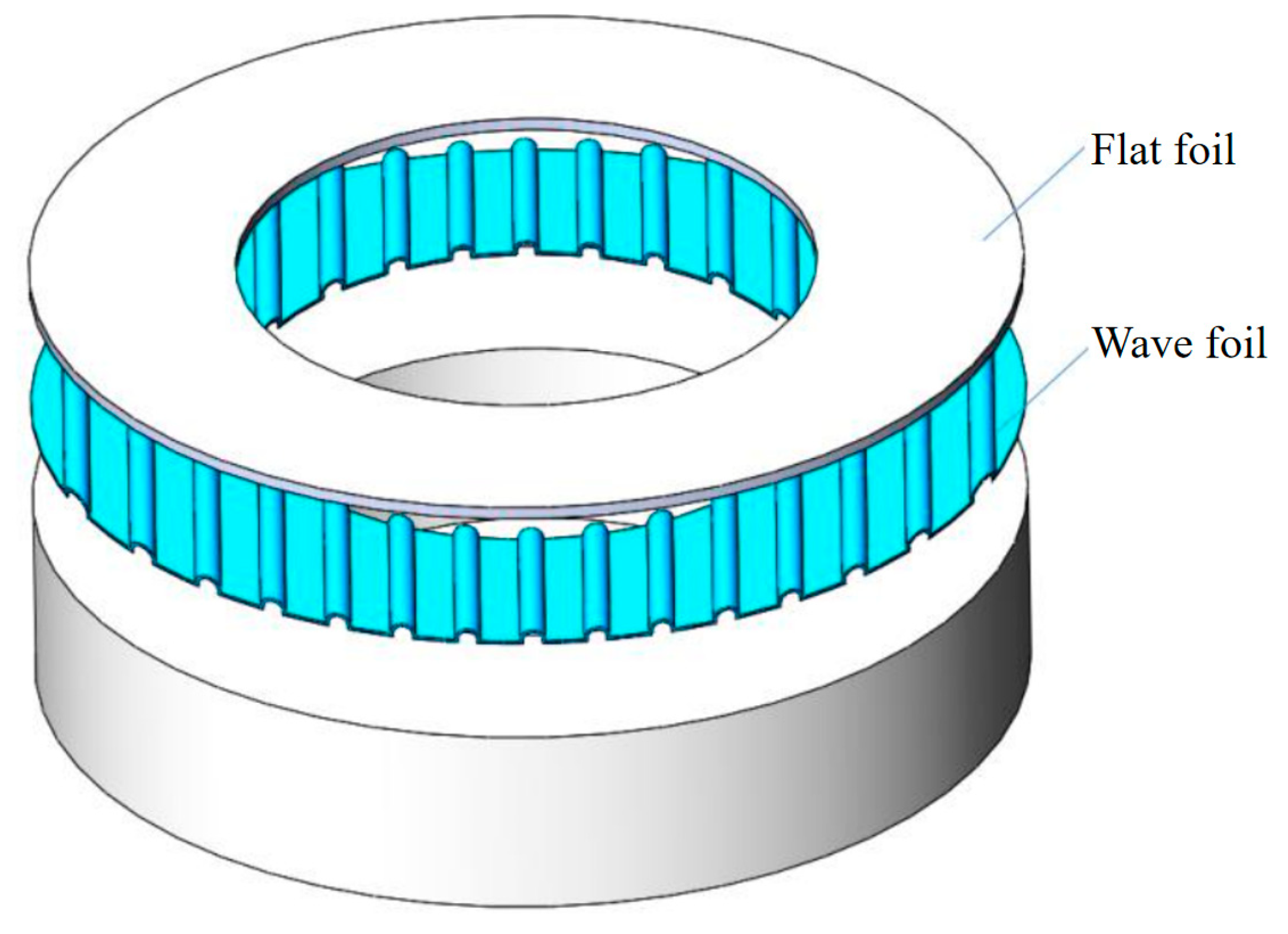
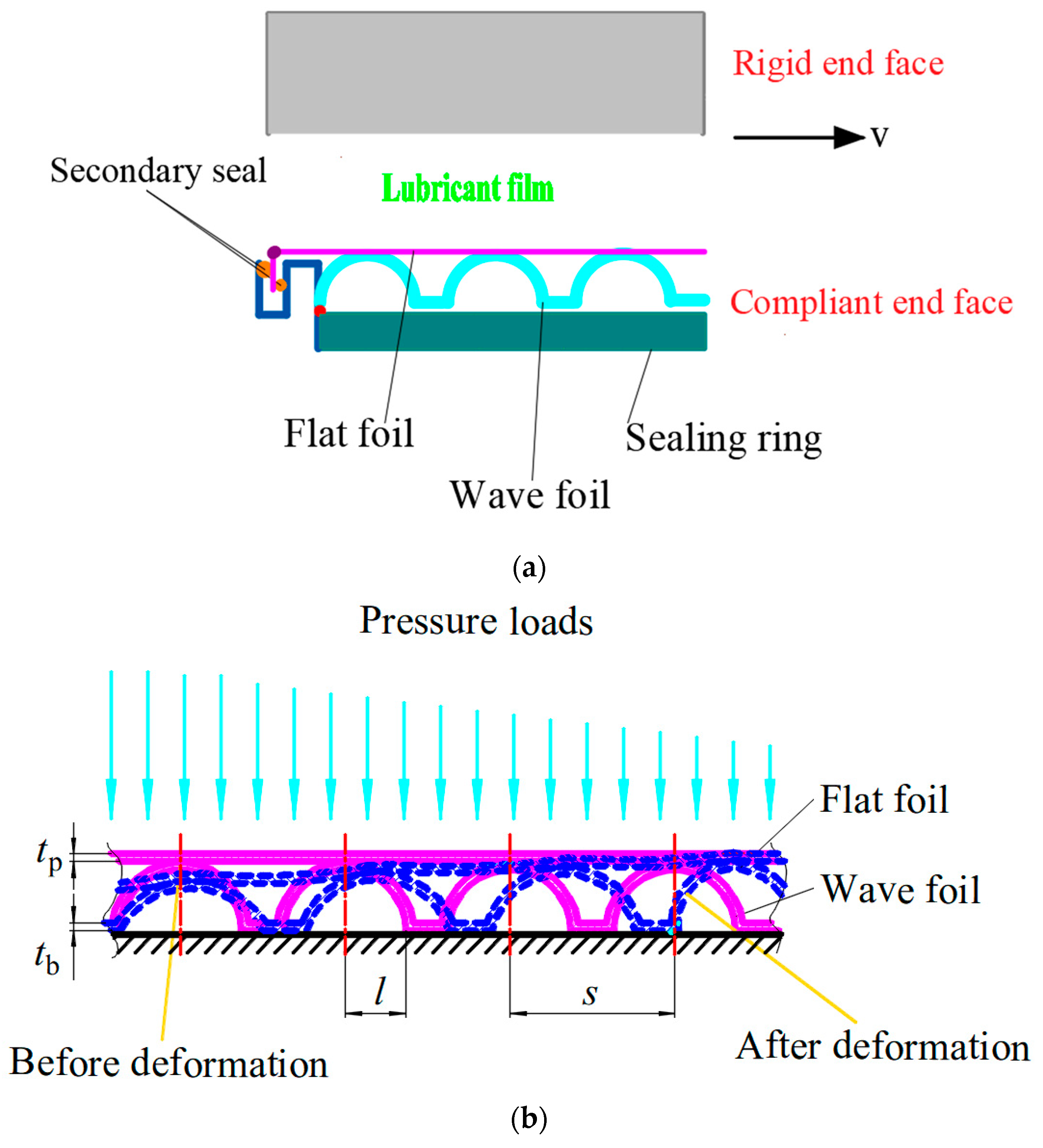
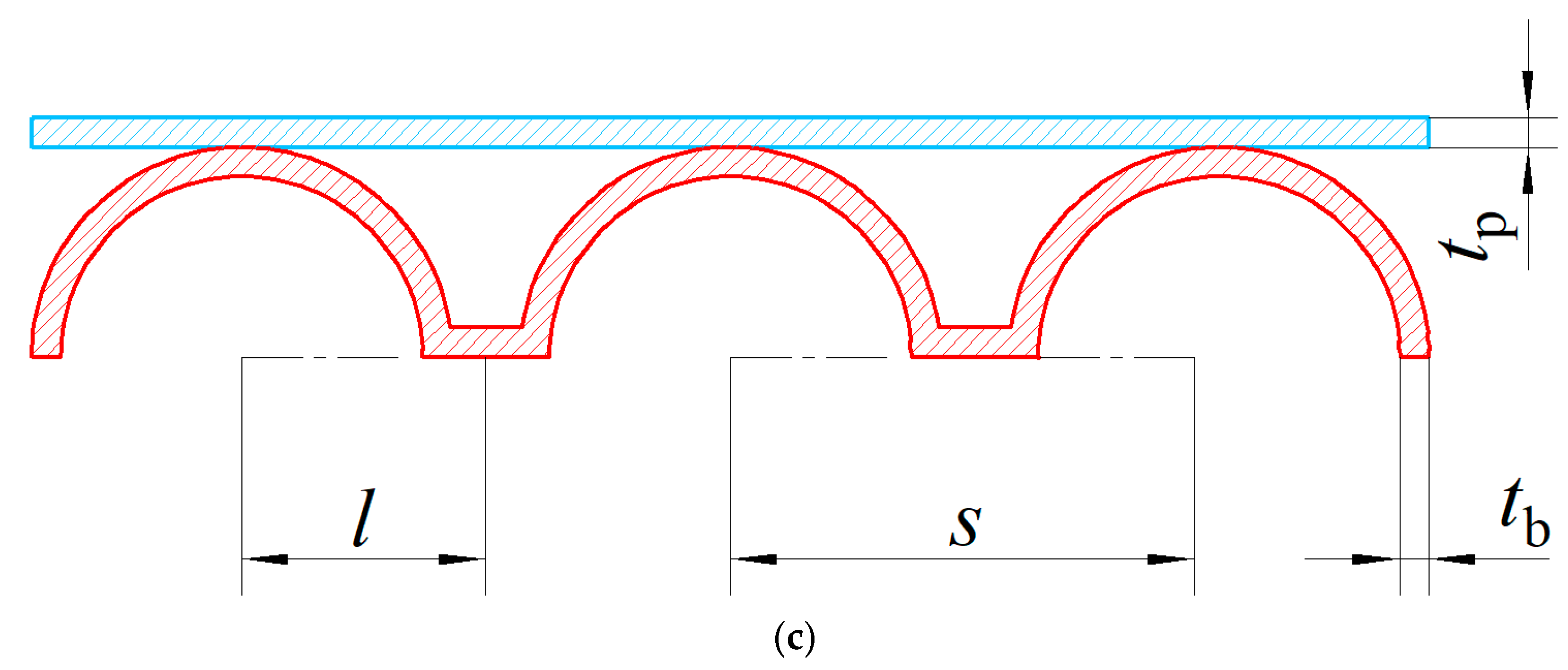
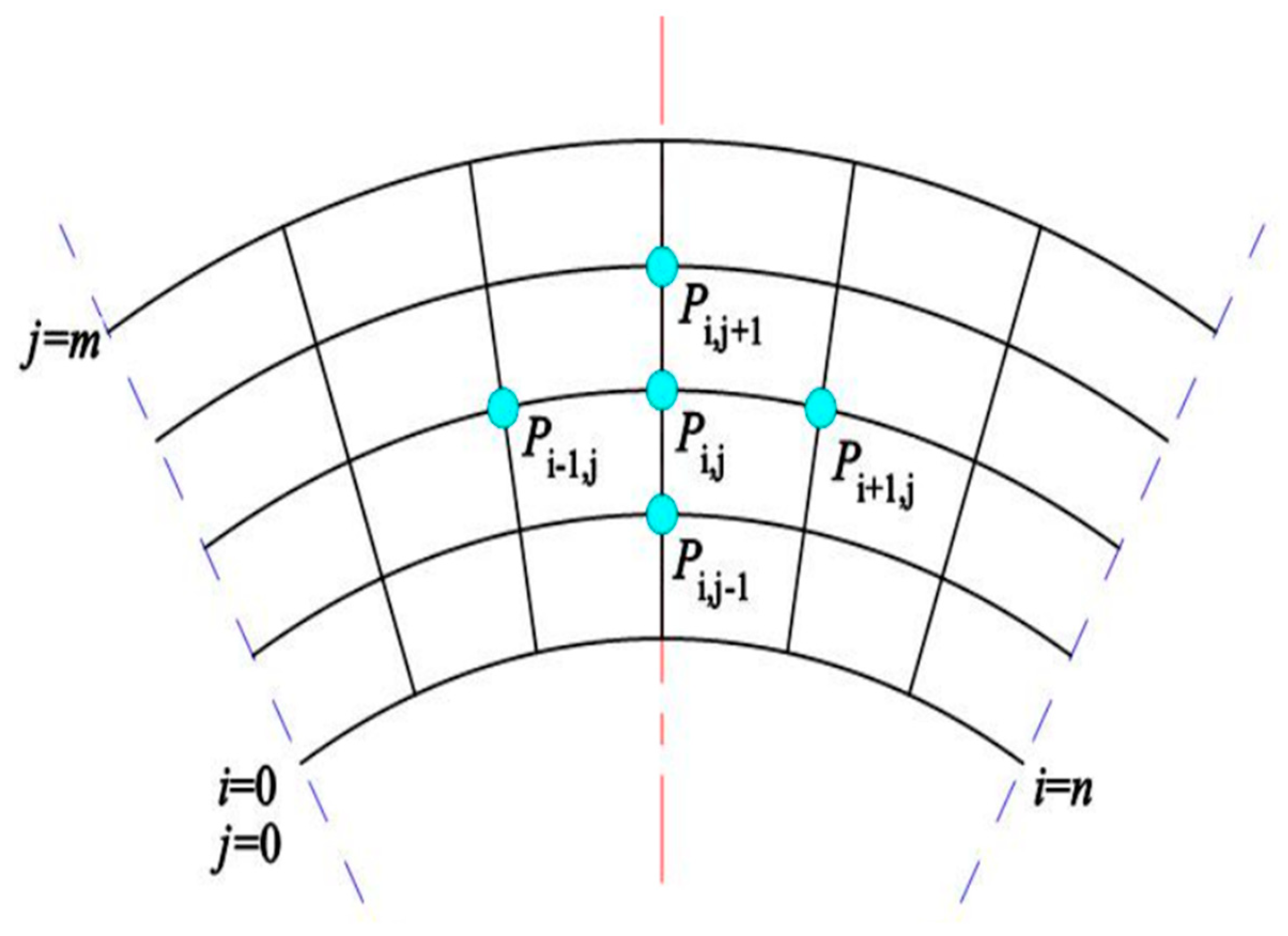
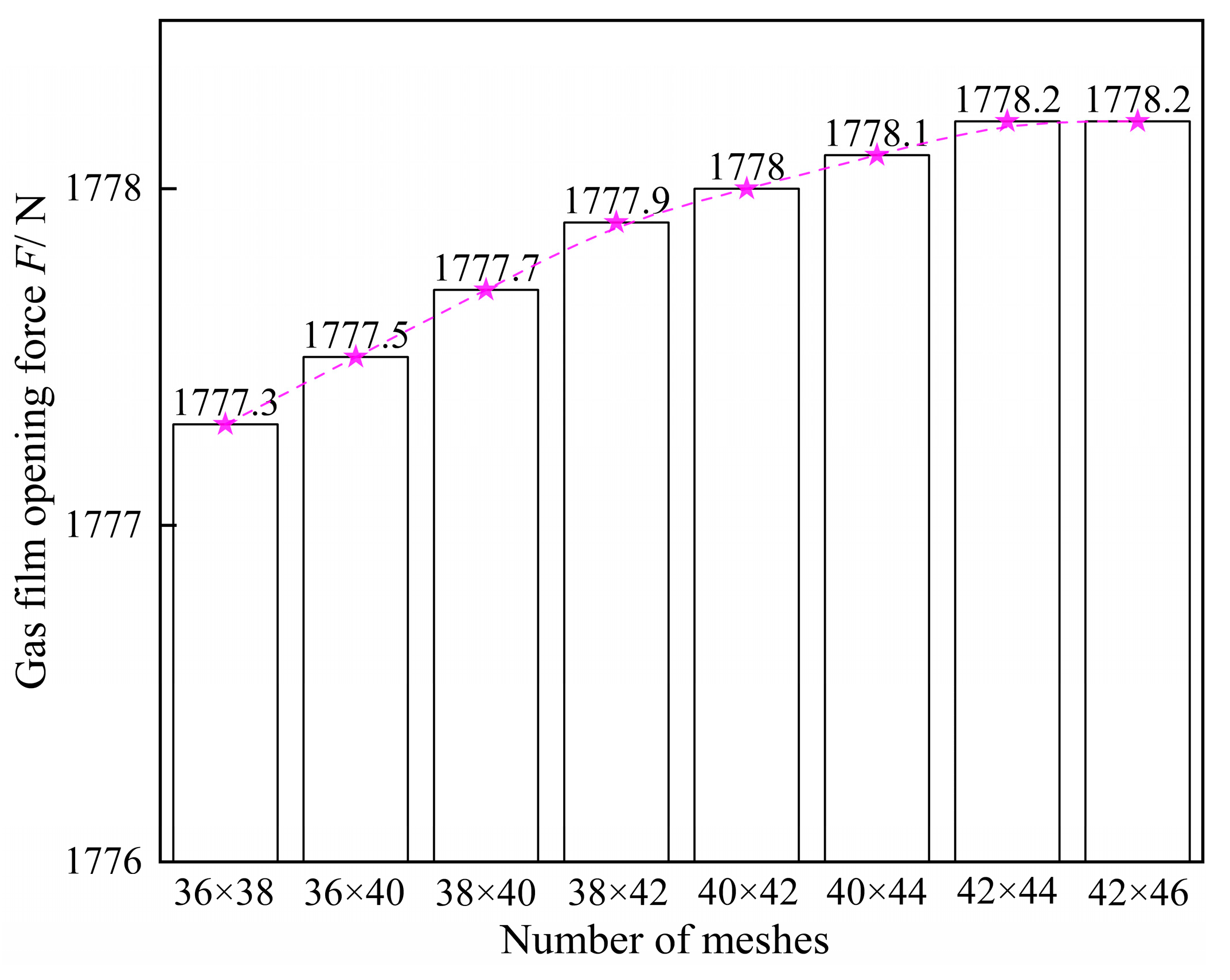
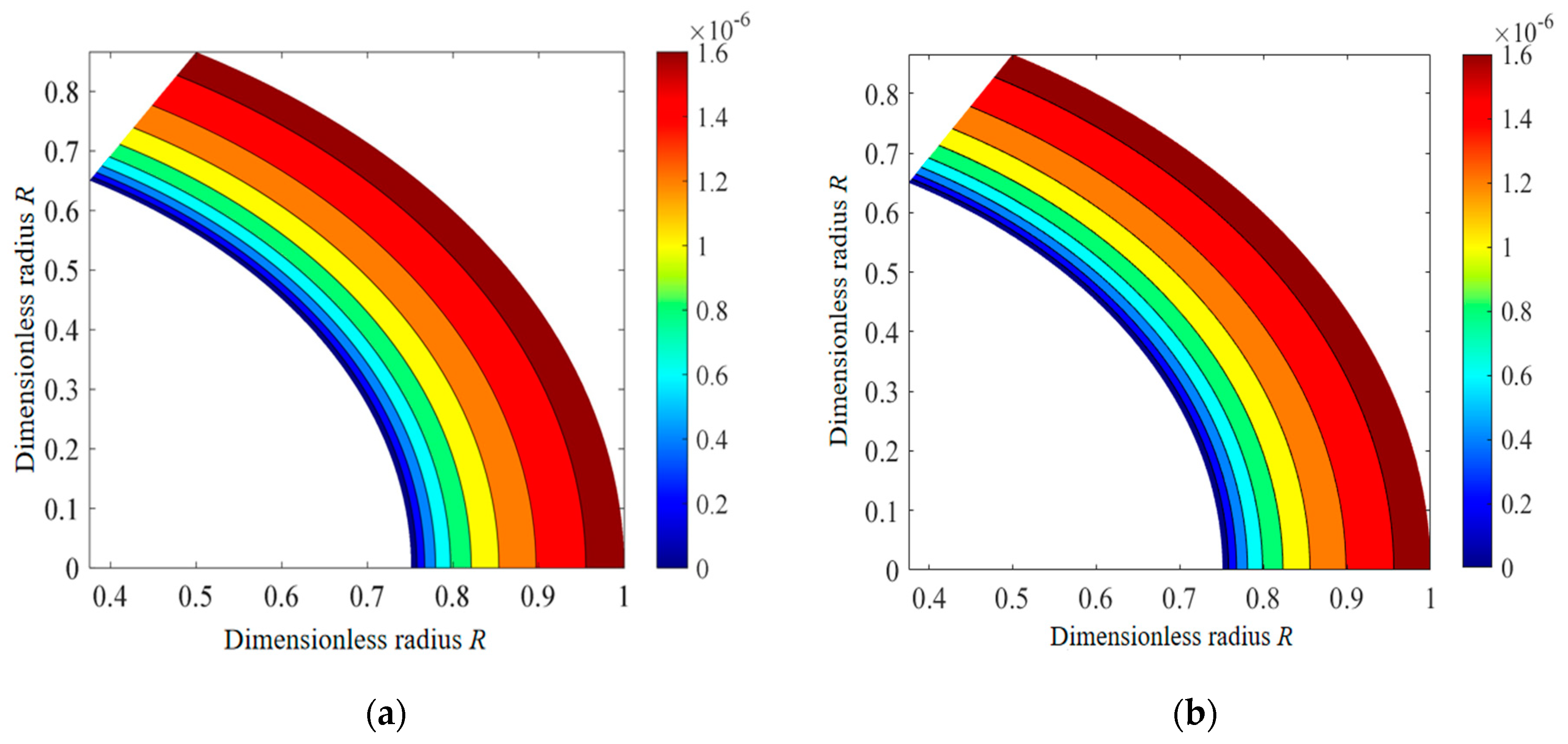
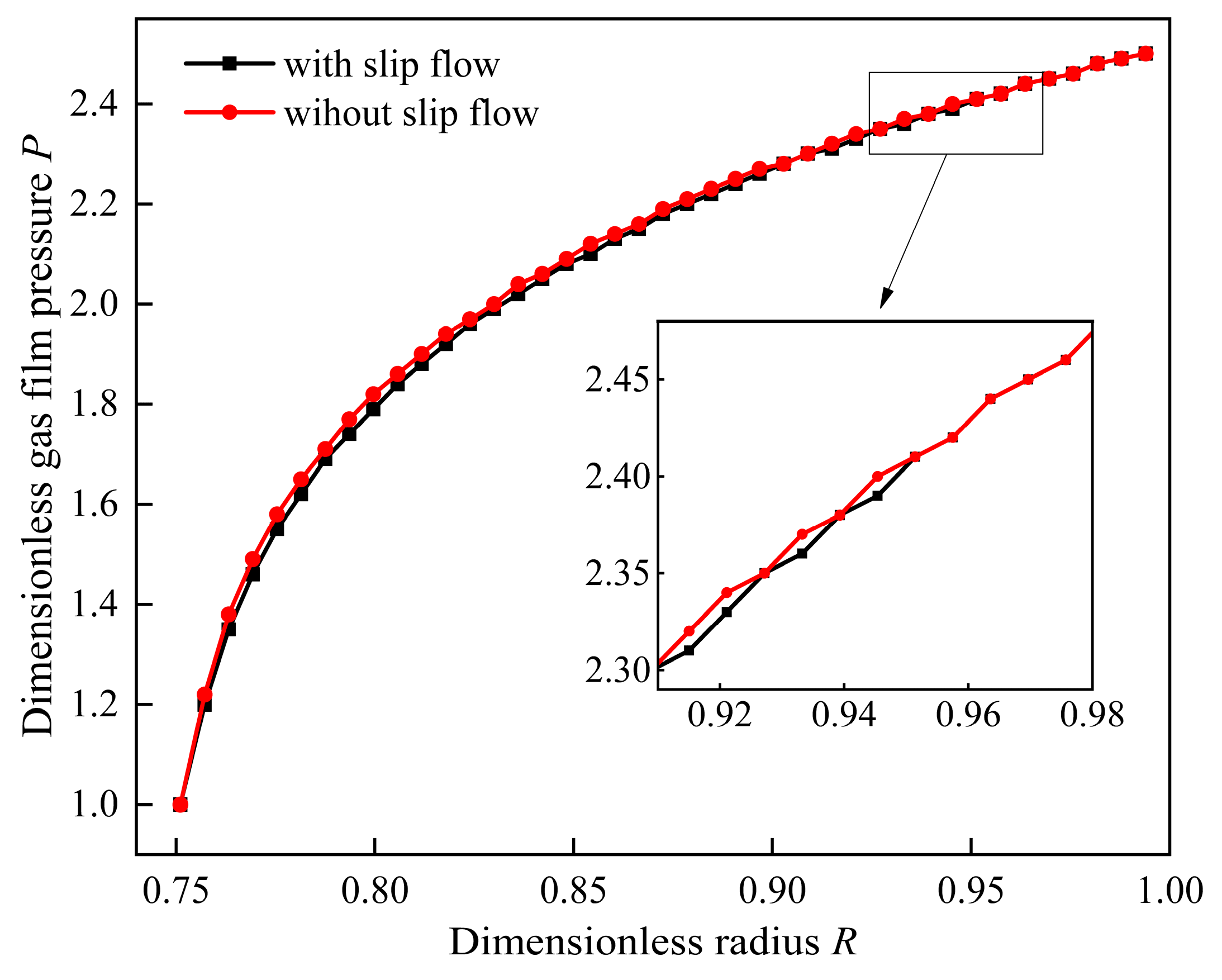
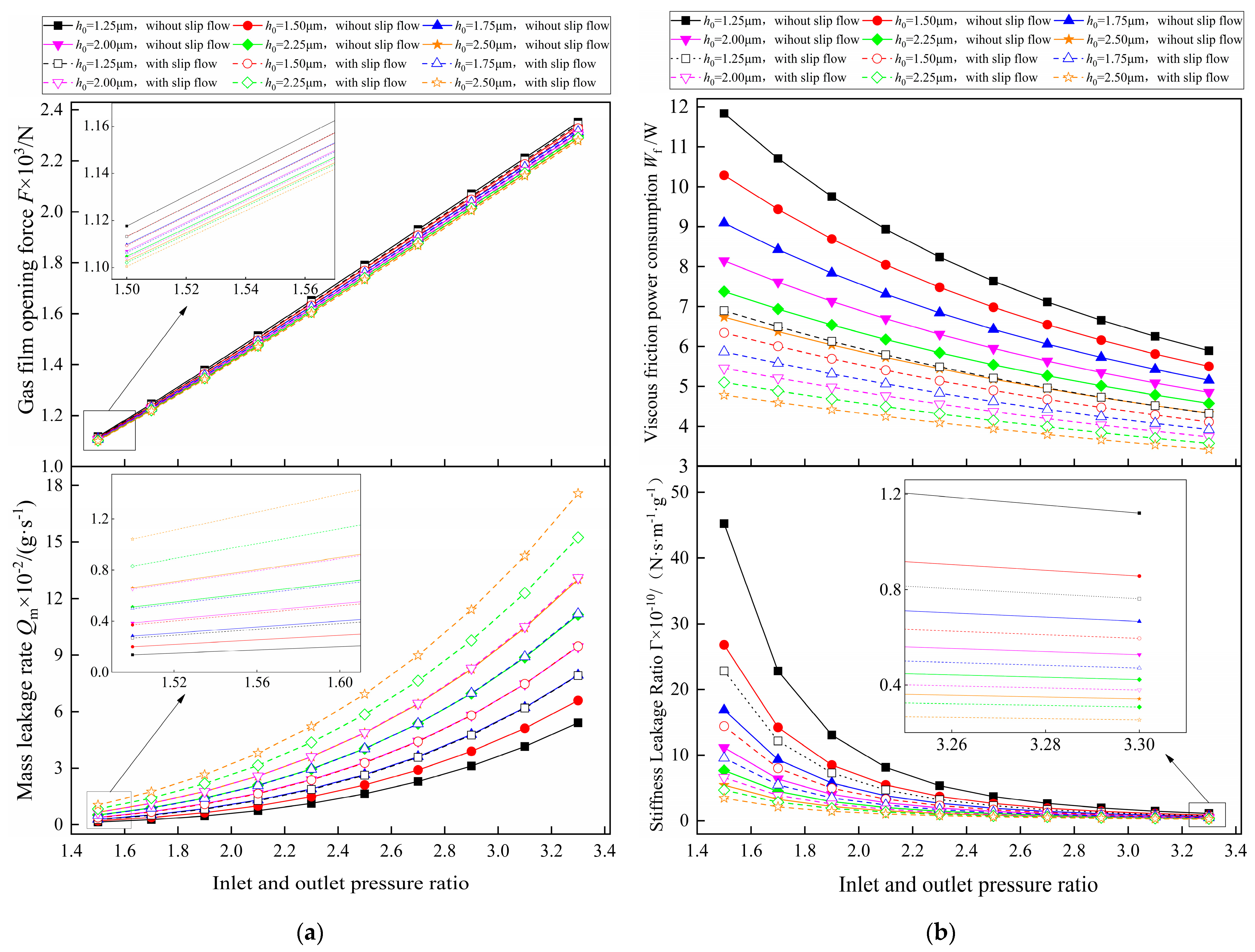
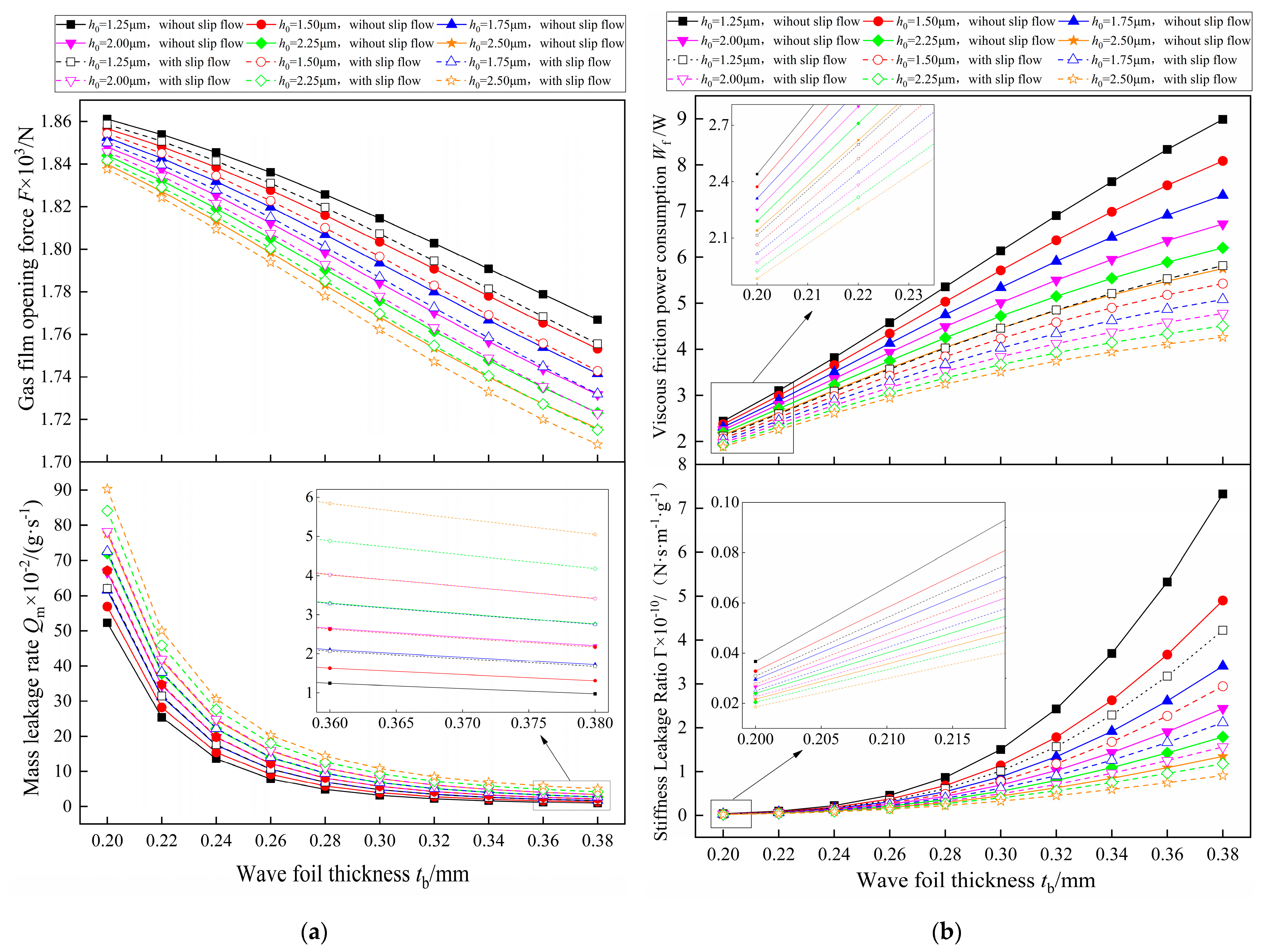
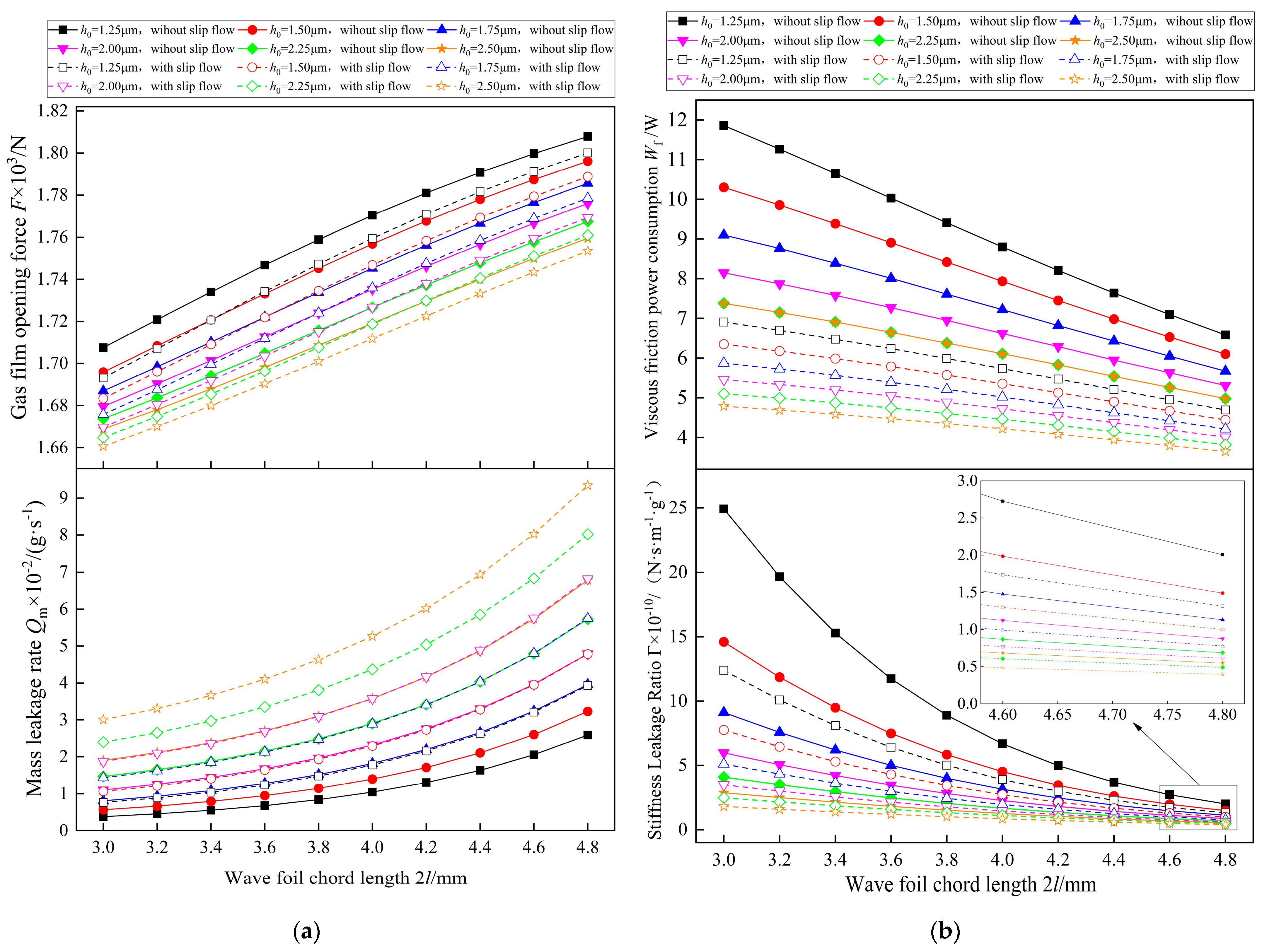

| Parameters | Numerical | Unit |
|---|---|---|
| outer radius | 77.78 | mm |
| inner radius | 58.42 | mm |
| minimum gas film thickness | 1.25–2.50 | μm |
| wave foil thickness | 0.20–0.38 | mm |
| flat foil thickness | 0.13–0.24 | mm |
| half of the chord length | 1.50–2.50 | mm |
| Poisson’s ratio of wave foil | 0.30 | - |
| Poisson’s ratio of flat foil | 0.30 | - |
| elastic modulus of wave foil | 2.00 × 1011 | Pa |
| elastic modulus of flat foil | 2.00 × 1011 | Pa |
| pitch | 3.20–5.00 | mm |
| Parameters | Numerical | Unit |
|---|---|---|
| Inlet and outlet pressure ratio | 1.50–3.30 | - |
| outlet pressure | 101,325 | Pa |
| rotation speed | 50,000 | r·min−1 |
| absolute temperature | 303.15 | K |
| Parameters | Numerical | Unit |
|---|---|---|
| medium | air | - |
| density | 1.1425 | kg·m−3 |
| viscosity | 1.8 × 10−5 | Pa·s |
| gas constant | 287.03 | - |
| Parameters | Validation Model I | Validation Model II |
|---|---|---|
| geometric model | 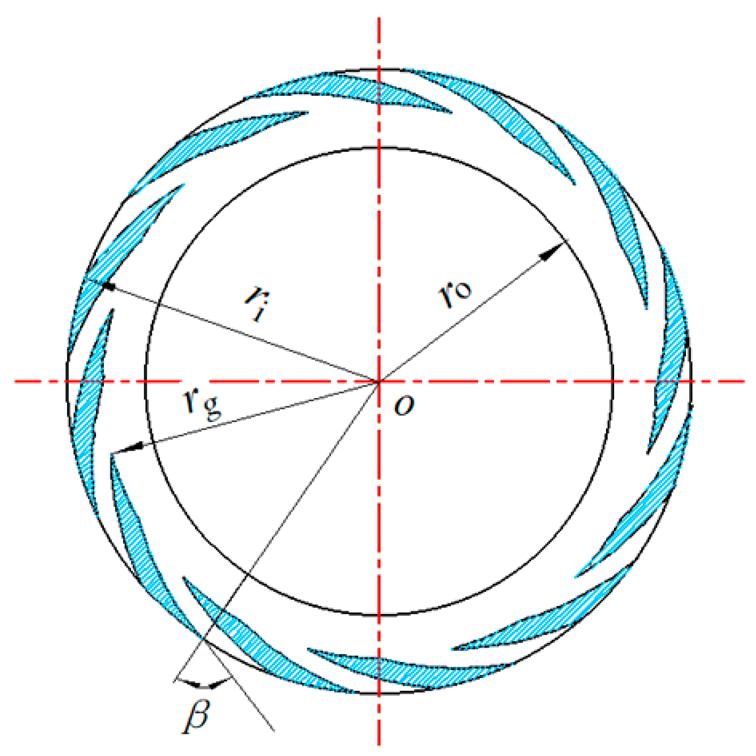 | 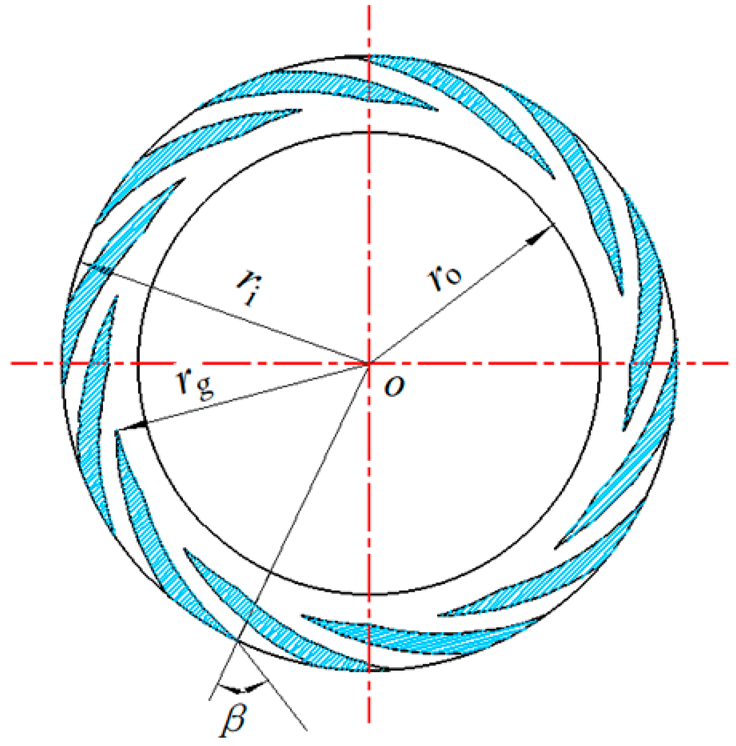 |
| spiral equation | ||
| 77.78 mm | 77.78 mm | |
| 58.42 mm | 58.42 mm | |
| 69 mm | 66.16 mm | |
| spiral angle | 75° | 75° |
| spiral-to-dam ratio | 1 | 1 |
| number of grooves N | 12 | 12 |
| 4 μm | 5 μm | |
| minimum gas film thickness | 3.05 μm | 3.05 μm |
| 4.5852 MPa | 0.405 MPa | |
| 0.1013 MPa | 0.101 MPa | |
| 10,380 r·min−1 | 500 r·min−1 | |
| medium | air | air |
| temperature | 300 K | 300 K |
| dynamic viscosity | 1.8 g·m·s−1 | 1.79 g·m·s−1 |
Disclaimer/Publisher’s Note: The statements, opinions and data contained in all publications are solely those of the individual author(s) and contributor(s) and not of MDPI and/or the editor(s). MDPI and/or the editor(s) disclaim responsibility for any injury to people or property resulting from any ideas, methods, instructions or products referred to in the content. |
© 2024 by the authors. Licensee MDPI, Basel, Switzerland. This article is an open access article distributed under the terms and conditions of the Creative Commons Attribution (CC BY) license (https://creativecommons.org/licenses/by/4.0/).
Share and Cite
Jiang, H.; Yu, S.; Ding, X. Parametric Analysis of Compliant End Face Gas Film Seals Considering Slip Flow Effects. Appl. Sci. 2024, 14, 6953. https://doi.org/10.3390/app14166953
Jiang H, Yu S, Ding X. Parametric Analysis of Compliant End Face Gas Film Seals Considering Slip Flow Effects. Applied Sciences. 2024; 14(16):6953. https://doi.org/10.3390/app14166953
Chicago/Turabian StyleJiang, Haitao, Shurong Yu, and Xuexing Ding. 2024. "Parametric Analysis of Compliant End Face Gas Film Seals Considering Slip Flow Effects" Applied Sciences 14, no. 16: 6953. https://doi.org/10.3390/app14166953






